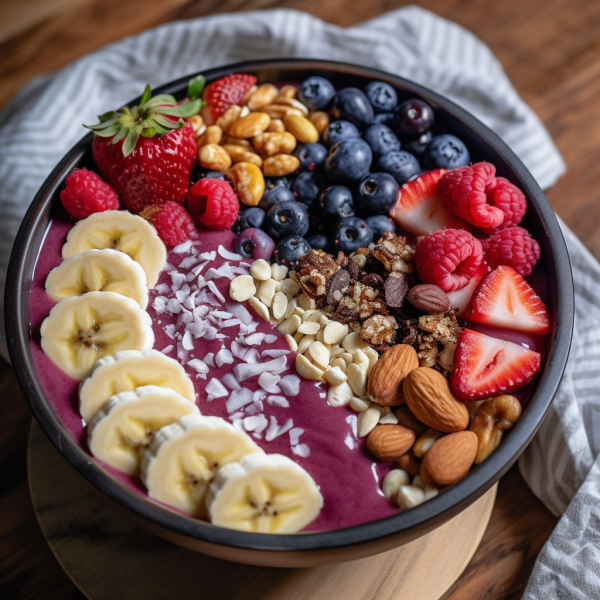Acai Bowl Recipe: How to Make the Perfect Healthy Breakfast Bowl

Acai bowls have become a popular breakfast and snack option in recent years, thanks to their delicious taste and numerous health benefits. Made from acai berries, which are native to Brazil, these bowls are packed with antioxidants, fiber, and healthy fats. They are also incredibly versatile, as you can customize them with a variety of toppings to suit your taste preferences.
To make an acai bowl, you’ll need a few key ingredients, including frozen acai puree, a liquid of your choice (such as almond milk or coconut water), and a variety of toppings (such as fresh fruit, granola, and nut butter). The process is fairly simple – just blend the acai puree and liquid together until smooth, then add your desired toppings. With a little creativity, you can create a delicious and nutritious acai bowl that will satisfy your cravings and keep you feeling full and energized throughout the day.
Where does Acai come from?
The acai bowl originated in the Amazon region of Brazil, where the acai palm grows naturally. The acai berries harvested from these trees have been a staple in the diet of the indigenous communities for centuries, often consumed in the form of a pulp.
Acai bowls became a popular dish among surfers in the coastal regions of Brazil in the 1970s and 80s due to their energy-boosting properties. They crossed over to the United States in the early 2000s, where they rapidly gained popularity, particularly in health-conscious communities.
Today, these vibrant and versatile bowls have become a staple of global health and wellness cuisine, known not just for their colorful presentation, but also for their significant nutritional benefits.
Why has Acai become so popular?
Acai berries are often touted as a superfood, and for good reason. They are packed with antioxidants, which are substances that can prevent or slow damage to cells caused by free radicals. This high antioxidant content contributes to numerous health benefits, including boosting brain function, reducing cholesterol levels, and supporting overall heart health.
In addition to antioxidants, acai berries are rich in fiber, which can aid in digestion. They also contain heart-healthy fats and a small amount of protein.
Moreover, acai berries have a unique nutritional profile for a fruit, as they are relatively high in fat and low in sugar. This makes the acai bowl a fulfilling meal or snack that provides sustained energy throughout the day.
It’s important to note that while acai berries are highly nutritious, the overall nutritional content of an acai bowl will depend on the other ingredients used, especially the toppings. Thus, it’s always a good idea to consider the nutritional profile of the entire bowl, not just the acai.
Ingredients for your Acai bowl
An acai bowl is made up of the following variable ingredients:
Acai Puree
The base of an acai bowl is the acai puree. Acai is a small, purple berry that is native to the Amazon rainforest in Brazil. Acai berries are known for their high antioxidant content and are a great addition to any diet. Acai puree can be found in most grocery stores or online. Look for unsweetened puree to avoid added sugars.
Fruit Toppings
Fruit toppings are an essential part of an acai bowl. Choose fruits that are in season and ripe for the best flavor. Some popular fruit toppings include strawberries, blueberries, bananas, and mangoes. Cut the fruit into bite-sized pieces for easy eating.
Nut Toppings
Nuts are a great addition to an acai bowl as they add texture and healthy fats. Some popular nut toppings include almonds, cashews, and walnuts. Chop the nuts into small pieces for easy eating.
Liquid Base
A liquid base is necessary to blend the acai puree. Some popular options include almond milk, coconut water, or apple juice. Use a liquid that complements the other ingredients and adds flavor.
In summary, the key ingredients for an acai bowl include acai puree, fruit toppings, nut toppings, and a liquid base. Choose high-quality ingredients for the best flavor and nutrition.
Instructions
1. Preparing the Acai Puree
To prepare the acai puree, start by adding 2 packs of frozen acai puree and 1/2 cup of almond milk to a blender. Blend the mixture until it becomes smooth and creamy. If the mixture is too thick, add more almond milk, a tablespoon at a time, until it reaches the desired consistency.
2. Preparing the Fruit Toppings
For the fruit toppings, cut up your favorite fruits into bite-sized pieces. Some great options include sliced bananas, strawberries, blueberries, and kiwis. Arrange the fruit on a plate or in small bowls so that they are ready to be added to the acai bowl.
3. Preparing the Nut Toppings
For the nut toppings, chop up a handful of nuts such as almonds, walnuts, or pecans. You can also add some shredded coconut or granola for additional texture and flavor.
4. Blending the Acai Bowl
Once the acai puree is smooth and creamy, it is time to assemble the acai bowl. Start by pouring the acai puree into a bowl. Then, add the fruit toppings and nut toppings on top of the puree. You can also add a drizzle of honey or agave nectar for extra sweetness.
Enjoy the acai bowl immediately or store it in the freezer for up to 30 minutes to let it set.
Tips and Variations
Acai bowls are very versatile and can be adjusted in quite a few different ways.
Choosing the Right Acai Puree
When making an acai bowl, the quality of the acai puree is essential. Look for purees that are unsweetened and free of any additives or preservatives. Some brands may also offer organic options. Frozen acai puree is a great option, as it will give your bowl a thick and creamy texture. Before using the puree, let it thaw for a few minutes to make it easier to blend.
Experimenting with Different Fruit Combinations
One of the best things about making acai bowls is that you can experiment with different fruit combinations to create unique and delicious bowls. Some popular fruits to add to your acai bowl include bananas, strawberries, blueberries, and mangoes. You can also try adding tropical fruits like pineapple, papaya, or dragon fruit. Experiment with different combinations to find your perfect bowl.
Adding Superfoods to Your Acai Bowl
Superfoods are a great way to add extra nutrition to your acai bowl. Some popular superfoods to add include chia seeds, flax seeds, hemp seeds, goji berries, and bee pollen. These ingredients are packed with antioxidants, vitamins, and minerals that can help boost your immune system and improve your overall health.
Making Your Acai Bowl Vegan or Gluten-Free
If you have dietary restrictions, you can still enjoy a delicious acai bowl. To make your bowl vegan, use a plant-based milk like almond or coconut milk instead of dairy milk. You can also use agave or maple syrup instead of honey. To make your bowl gluten-free, make sure to use gluten-free granola and avoid any toppings that may contain gluten, like cookies or cake.
By following these tips and variations, you can create a delicious and nutritious acai bowl that is perfect for any time of day.
Acai serving and storage suggestions
Acai bowls are a versatile food option that can be enjoyed at any time of the day. They are often consumed as a breakfast meal due to their blend of healthy fats, fiber, and natural sugars, providing sustained energy for the day ahead. However, they also make an excellent snack or dessert option, especially on a hot day when you’re craving something refreshing. Due to their richness, they can even be served as a light lunch.
When considering accompanying beverages or foods, remember that acai bowls are quite filling on their own. If you’re having an acai bowl for breakfast, a light beverage such as a herbal tea or freshly squeezed juice might complement it nicely. For a heartier breakfast or brunch, consider pairing it with a side of whole-grain toast or a boiled egg. If you’re enjoying an acai bowl as a dessert, a cup of decaffeinated coffee or tea could provide a nice balance.
As for storage advice, acai bowls are best eaten immediately after they’re prepared to enjoy the full freshness of the fruits and to prevent the toppings from becoming soggy. However, if you have leftovers or want to prepare an acai bowl for later, you can store the acai base separately in an airtight container in the refrigerator for up to 24 hours. Just remember to add your toppings right before eating for optimal texture and taste.
